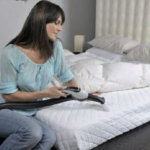When building a new country house, I decided to take into account the mistakes made during the construction of the old building. I paid special attention to the deplorable state of the crowns of the old dacha: in those places where the timber was in contact with the pillars of the foundation, the tree was especially susceptible to decay. A roofing material that served as a waterproofing laying between the foundation and the house was partially or in places completely collapsed. In these places, the tree suffered especially hard, in some places literally only dust remained from it. Such a crown did not have long to live!
Therefore, when building a new country house, I decided to approach the problem of adjoining the foundation to the house thoroughly, because. e. – using modern materials.
Firstly, I refused to use roofing material. As a result of the search for a material for waterproofing, I settled on a water-based bitumen-polymer mastic – ELASTOPAZ. This material is also known in Russia as one-component liquid rubber.
Such mastic does not require any preliminary preparation: it does not need to be heated, cut or rolled on the foundation.
You can read more about the strip foundation and its waterproofing with liquid rubber on a specialized website at the link
In short, the mastic is applied very easily: open a plastic bucket – and go ahead! It is very convenient to apply the material on a horizontal surface with a rubber spatula. You can also use a brush or roller – the material is elastic like paint, so it fits perfectly on the base without any problems or additional efforts.
In addition, it is very convenient for them to process hard-to-reach places: technological holes or junctions, equipment attachment points. To do this using roofing material is almost impossible: you will suffer, and the result will look very clumsy.
Literally in half an hour I processed the entire upper edge of the foundation with mastic. And then, after waiting for the first layer to dry, I smeared the surface again to be sure. The result was a layer of waterproofing with a thickness of about 3 millimeters. Absolutely flat surface, without seams and scuffs, with clear processing of corners and junctions. Now you can calmly lay the crown of a new house on this foundation: moisture from the soaked foundation will never go to a wooden base of the house and will not destroy it.
I still have some material left in the last 18 kg bucket. With it, I processed the columnar foundation of the gazebo, as well as the pillars of the gate and fence. I want to say that it was very easy to do this, compared to how I got dirty with tar last time! By the way, about the use of Elastopaz mastic not only in the country, but also for waterproofing in an apartment, you can read in detail here.
As for the use of this mastic in the country and at home, the main advantage is due to the fact that no special skills and knowledge are required, no need to heat the mastic and no need to dilute with solvents. In a word, this is the most reliable and convenient way for do-it-yourself waterproofing.








